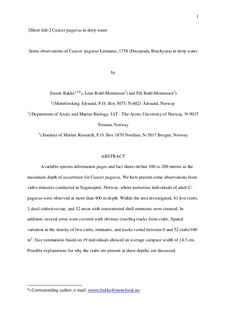| dc.contributor.author | Bakke, Snorre | |
| dc.contributor.author | Buhl-Mortensen, Lene | |
| dc.contributor.author | Buhl-Mortensen, Pål | |
| dc.date.accessioned | 2020-01-15T08:46:08Z | |
| dc.date.available | 2020-01-15T08:46:08Z | |
| dc.date.created | 2019-03-04T10:50:08Z | |
| dc.date.issued | 2019 | |
| dc.identifier.citation | Crustaceana. 2019, 92 (1), 95-105. | nb_NO |
| dc.identifier.issn | 0011-216X | |
| dc.identifier.uri | http://hdl.handle.net/11250/2636319 | |
| dc.description.abstract | Available species information pages and fact sheets define 100 to 200 m as the maximum depth of occurrence for Cancer pagurus. We here present some observations from video transects conducted in Sognesjøen, Norway, where numerous individuals of adult C. pagurus were observed at more than 400 m depth. Within the area investigated, 81 live crabs, 3 dead crabs/exuviae, and 32 areas with concentrated shell remnants were counted. In addition, several areas were covered with obvious crawling tracks from crabs. Spatial variation in the density of live crabs, remnants, and tracks varied between 0 and 52 crabs/100 m2. Size estimations based on 19 individuals showed an average carapace width of 14.5 cm. Possible explanations for why the crabs are present at these depths, are discussed. | nb_NO |
| dc.language.iso | eng | nb_NO |
| dc.title | Some observations of Cancer pagurus Linnaeus, 1758 (Decapoda, Brachyura) in deep water | nb_NO |
| dc.type | Journal article | nb_NO |
| dc.type | Peer reviewed | nb_NO |
| dc.description.version | submittedVersion | nb_NO |
| dc.source.pagenumber | 95-105 | nb_NO |
| dc.source.volume | 92 | nb_NO |
| dc.source.journal | Crustaceana | nb_NO |
| dc.source.issue | 1 | nb_NO |
| dc.identifier.doi | 10.1163/15685403-00003857 | |
| dc.identifier.cristin | 1682042 | |
| cristin.unitcode | 7431,8,0,0 | |
| cristin.unitcode | 7431,28,0,0 | |
| cristin.unitname | Fiskerifaglig senter | |
| cristin.unitname | Bunnsamfunn og kystinteraksjon | |
| cristin.ispublished | true | |
| cristin.fulltext | postprint | |
| cristin.qualitycode | 1 | |
